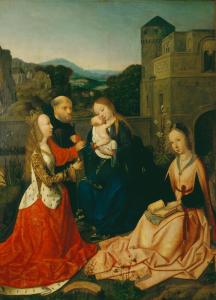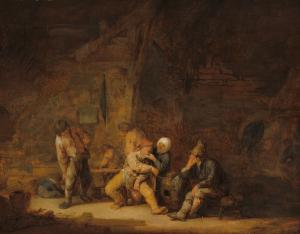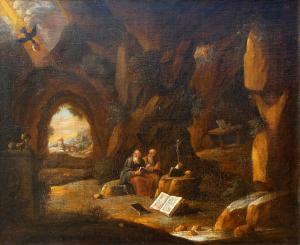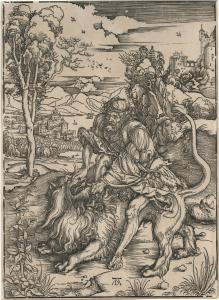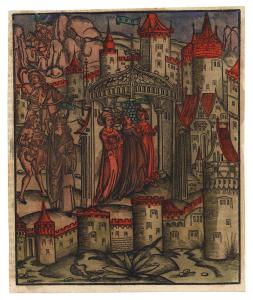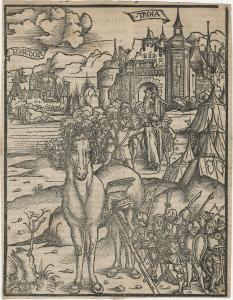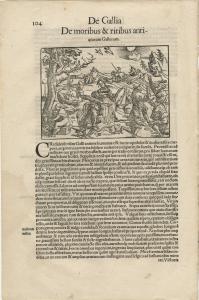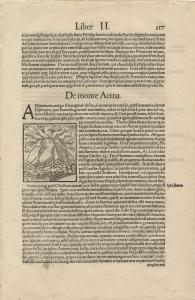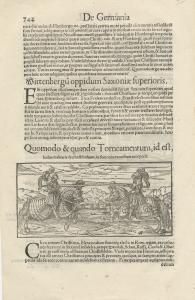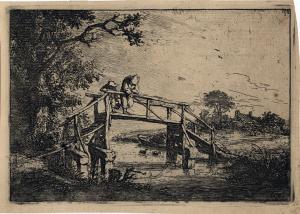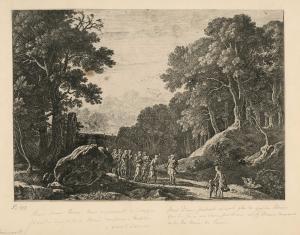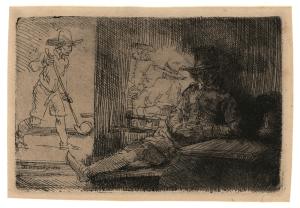In the 15th-17th centuries, Dutch and German art flourished through the Northern Renaissance and Dutch Golden Age periods. The advent of increasingly global and lucrative trade centers, coupled with the onset of the Protestant Reformation, created new spaces for innovation in technique and subject matter. The rising merchant class resulting from the growing trade economy fueled the demand for more naturalistic genre scenes, with images of everyday life beginning to gain popularity. As a result, the number of skilled local artists also continued to increase in order to fulfill these needs. Newly developed techniques in oil painting and printmaking drove the adoption of a new artistic tradition of portraying landscapes and narratives in great detail and faithfulness to reality for a popular audience.
Curator's Statement
My own interest in Northern European art has developed from my studies and personal travel to Belgium and the Netherlands. Northern European artworks tell a compelling story, embracing humorous scenes, layers of interactions between subjects, and often unflinching portrayals of reality. It is interesting to examine a work of art from this period and discuss all of its details, symbols, and historical references in order to gain a fuller understanding of the narrative being depicted. As a double major in English and history and an art history minor, I have an appreciation for the traditions of humanism and global thinking which revolutionized Northern Europe and drove the evolution of these artistic styles. Courses I have taken in Georgetown’s art history department on topics such as the history of prints and Baroque art have also exposed me to a larger timeline of the development during this period. Working in the Booth Family Center for Special Collections at the Georgetown University Library this summer has given me the opportunity to explore this area of interest further, especially through interacting with the new Barringer Collection prints, two of which are referenced below, and Georgetown’s greater collection of Northern European art from which this online exhibition is drawn.
Paintings
The widespread adoption of oil painting over other mediums such as tempera radically changed the painting style of Northern Europe, allowing for greater detail and new developments in light, perspective and realism. Notable painters such as Rogier van der Weyden, Gerard David, and Jan van Eyck pioneered the use of oil painting to achieve vibrant colors and intense detail drawing from oil paint’s ability to capture reflections and interior shadows.
Madonna and Child with Saints
Dirck van Hoogstraten (Flemish)
ca. 1525
Oil on board (wood)
1957.2.1
Gift of L. N. W. Abrons
Executed with intricate detail, this painting portrays the Holy Family along with Saint Catherine of Alexandria and Saint Barbara. The highly detailed landscape and the use of religious symbolism are typical of Flemish art from this period. The Christian iconography includes elements such as the wheel representing St. Catherine and her martyrdom, lilies symbolizing purity and the Virgin Mary, and the tower referencing St. Barbara and her time in captivity.
A Company of Peasants
Adriaen van Ostade (Dutch)
ca. 1634-1638
Oil on board (wood)
2018.1.12
Gift of the Corcoran Gallery of Art
This genre scene of peasants exemplifies the themes of Dutch Golden Age painting, showing a glimpse into the daily life of lower class members of society. The figures are shown working but also in merriment, suggesting a less cynical view of peasantry.
Saints Anthony and Paul in a Cave
School of David Teniers the Younger (Flemish)
ca. 1635
Oil on canvas
1111.1.946
In this painting, the hermit saints Anthony and Paul are shown glancing upwards amidst their devotional prayer in a cave. A raven flies down from the sky in a stream of golden light, bringing them bread from heaven. In addition to his prolific genre and landscape painting, Teniers created a significant number of paintings depicting religious hermits such as Saint Anthony in the desert or caves.
Prints
Although woodblock printing had existed in Asia long before its arrival in Europe, the technique gained popularity in Northern Europe in the 15th century, with the newly-invented printing press driving a need for printed book illustrations. In particular, Albrecht Dürer revolutionized the woodcut’s capacity for detail and shading through his prolific printmaking. Later the technique of etching gained popularity, largely due to artists such as Rembrandt van Rijn, as another mechanism for printmaking, allowing for very fine detail and drawing-like depictions.
Samson Rending the Lion
Albrecht Dürer (German)
ca. 1497-98
Woodcut
Gift of the Estate of George M. and Penelope Barringer
In this fantastic image of the biblical story of Samson slaying the lion, Dürer depicts the scene in dramatic fashion, with Samson grabbing the lion’s mouth as he wrestles with it. The lion’s mane is rendered in great detail, and the landscape in the background demonstrates an impressive development of perspective in the woodblock print. By portraying this famous struggle, Dürer alludes to the success of Christianity in defeating a manifestation of evil or the devil.
Untitled [Walled cityscape]
Studio of Michael Wolgemut (German)
ca. 1497
Woodcut with hand coloring on paper
1979.6.59
Gift of Eric F. Menke
This cityscape is taken from a page of the Nuremberg Chronicle, an early printed book that is notable for its abundant illustrations and its attempt to recount the history of the world from creation onwards. This particular scene shows a city with figures representing civil and military life. Artist Michael Wolgemut and Nuremberg Chronicle printer Anton Koberger were also connected with Dürer, who apprenticed under Wolgemut and was the godson of Koberger.
Folio from Virgil's Aeneid
Johann Gruninger (German)
ca.1517
Woodcut
Gift of the Estate of George M. and Penelope Barringer
This woodcut print comes from an edition of Virgil’s Aeneid which included illustrations created by printmaker Johann Gruninger. The image depicts the moments before the famous invasion of Troy, with Greek soldiers climbing inside the Trojan horse to hide before it is brought within the city’s walls under the auspices of a gift.
Cosmographia: Liber II pp. 103-104 (De Gallia), 257-258 (De Italia), Liber III pp. 743-744 (De Germania)
Sebastian M. Münster (German)
1550
Letterpress with woodcut on paper
2008.17.5, 2008.17.9, 2008.17.16
Gift of Joseph E. Jeffs, 2009
Containing maps, woodcut illustrations, and detailed written descriptions, the Cosmographia is the oldest German description of the world. The pages shown above depict the customs and behaviors of the ancient Gauls, an eruption of Mount Etna, and a German military tournament.
The Anglers
Adriaen van Ostade (Dutch)
ca.1653
Etching on paper
1111.1.5232
In this pensive etching, two individuals lean over on a bridge as they fish with rods in a stream set in a pastoral landscape. As is visible in The Anglers and A Company of Peasants, Ostade typically portrayed scenes from the daily lives of regular people, eschewing grandiosity in favor of close adherence to reality and modest, unassuming themes.
Venus Offering Diana a Choice Between Cupid and the Young Adonis
Herman van Swanevelt (Dutch)
1654
Etching on paper
1111.1.5444
Venus leads the small Cupid and Adonis towards Diana and her tribe of female hunting companions in the middle of a forest in this image. According to mythology, Venus falls in love with Adonis after she is shot with Cupid’s arrow while seeing him hunting in the forest.
The Golf Player
Rembrandt Harmenszoon van Rijn (Dutch)
1654
Etching on paper
1982.2.1
Gift of Adam Stolpen
This etching depicts a man sitting gloomily inside a room, cloaked in shadows, as others enjoy a game of golf in the daylight outside. Golf and similar stick and ball games were popular in the Netherlands in the 17th century, and Dutch colonists are believed to have first brought the game to America. This print was created a few years before Rembrandt’s near-bankruptcy scandal and the following decline and eventual end of his career.
Sources/Further Reading
National Gallery of Art:
https://www.nga.gov/collection/paintings/NorthernEuropean15th16thcenturies.html
Metropolitan Museum of Art:
https://www.metmuseum.org/toah/hd/wdct/hd_wdct.htm
https://www.metmuseum.org/toah/hd/gnrn/hd_gnrn.htm
https://www.metmuseum.org/toah/hd/optg/hd_optg.htm
New Netherland Institute:
https://www.newnetherlandinstitute.org/history-and-heritage/additional-resources/dutch-treats/the-dutch-origins-of-golf/
Guest curated by Maeve Silk (COL '23), with guidance from Art Curator LuLen Walker.

